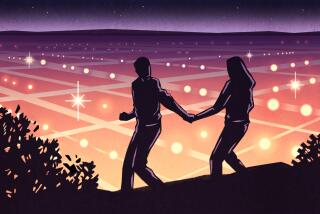‘Reach for the Stars’ : Just Back From Space Shuttle Mission, Astronaut Advises Students at His Alma Mater to Aim High
- Share via
WESTCHESTER — Aspiring astronaut Kristen Burton, 18, came face to face earlier this week with a hero straight out of her dreams.
“It’s amazing I got to meet somebody that has actually been up in space,” said the St. Bernard High School senior. “Just to shake his hand is incredible.”
Burton and more than 1,000 students and teachers at the Catholic school in Playa del Rey gathered in the gym Monday to hear a personal account of the U.S. space program from one of the school’s most illustrious alumni, NASA astronaut Kevin Chilton.
Chilton, a 1972 graduate of St. Bernard, co-piloted the space shuttle Endeavour to a safe landing a little more than two weeks ago, ending a historic nine-day mission. Eager to address the class of 1992 before graduation, he ducked out of debriefing sessions to visit the campus.
Wearing a dark-blue NASA flight suit, Chilton thanked the school for its prayers and encouraged students to “reach for the stars.”
“At least then if you reach for the stars and only reach the moon, you know you’ve tried,” he said, adding that astronaut Neil Armstrong, after all, was quite happy to reach the moon.
After the hourlong assembly ended, about 50 students stayed to shake Chilton’s hand and get his autograph. Chilton answered their many questions, which ranged from “What was it like seeing the Earth from space?” to “How do you become an astronaut?”
In an interview, Chilton said he keeps close ties with St. Bernard in return for what he received there--a strong foundation of knowledge and spirituality that “made a big difference in what kind of person I turned out to be.”
Teachers had such a positive influence on him that he hopes to become one someday, he said. Meanwhile, he hopes his visits will inspire students to set goals.
During the assembly, Chilton candidly described his mission.
On the morning of takeoff on May 7, Chilton said, he was gripped by fear, not for his safety, but of making a mistake and letting down the crew and his loved ones.
But during prayer, he concluded that he could only do his best. Suddenly, he felt comforted and “ready to go.”
He said the acceleration during blastoff, which reached three times the force of gravity, “felt like a gorilla sitting on your chest.”
The next sensation was of zero gravity.
“All the dust rises off the floor, what little there is,” he said. “Pencils float off their pads.”
Each morning, the seven-member crew gathered around the fax machine to get messages from home. He was happy to find a message from St. Bernard the first morning.
He described his first sunrise from space--”an ever-growing arc of blue, with white clouds”--and said it affirmed his Christian beliefs.
But on the fourth day, the crew experienced problems in accomplishing a major mission goal--to capture and release a $150 million communications satellite traveling in a useless, low-Earth orbit.
A $7-million capture bar designed by NASA proved difficult to manipulate accurately and repeatedly sent the satellite into tailspins.
“We felt like complete and utter failures,” Chilton recalled. “It was the low point of the mission.”
Chilton described how the astronauts pledged to attend church every Sunday if they could catch the satellite. They gradually added days--Saturday, Friday--but by the final attempt, “we had used up every day of the week.”
So Chilton prayed for help from St. Jude, “patron saint of hopeless causes.” He said it must have worked.
On the third and final try, three astronauts successfully grabbed the satellite with their gloved hands during an 8-hour, 29-minute spacewalk, the longest in the history of the U.S. space program.
One good result of having so much difficulty with the satellite was that the mission received plenty of media attention, he said.
Chilton concluded his remarks by asking students to aim high when they set goals. He emphasized the importance of getting good grades, because grades are what potential employers and schools often use to make their first round of cuts among a pool of applicants.
He also stressed the value of persistence.
“We failed many times on this mission,” he said. “But we never gave up.”
The audience gave Chilton a standing ovation.
Chris, a 10th-grader wearing the school uniform of gray slacks and a white button-down shirt, said although he is not sure what he wants to be when he grows up, he plans to attend college and study hard.
Chilton showed him that dreams can be accomplished if we put our minds to it, he said. “The stars are the limit.”
More to Read
Sign up for Essential California
The most important California stories and recommendations in your inbox every morning.
You may occasionally receive promotional content from the Los Angeles Times.










